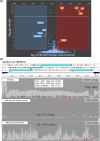Novel endogenous simian retroviral integrations in Vero cells: implications for quality control of a human vaccine cell substrate
- PMID: 29330501
- PMCID: PMC5766633
- DOI: 10.1038/s41598-017-18934-2
Novel endogenous simian retroviral integrations in Vero cells: implications for quality control of a human vaccine cell substrate
Abstract
African green monkey (AGM)-derived Vero cells have been utilized to produce various human vaccines. The Vero cell genome harbors a variety of simian endogenous type D retrovirus (SERV) sequences. In this study, a transcriptome analysis showed that DNA hypomethylation released the epigenetic repression of SERVs in Vero cells. Moreover, comparative genomic analysis of three Vero cell sublines and an AGM reference revealed that the genomes of the sublines have ~80 SERV integrations. Among them, ~60 integrations are present within all three cell sublines and absent from the reference sequence. At least several of these integrations consist of complete SERV proviruses. These results strongly suggest that SERVs integrated in the genome of Vero cells did not retrotranspose after the establishment of the cell lineage as far as cells were maintained under standard culture and passage conditions, providing a scientific basis for controlling the quality of pharmaceutical cell substrates and their derived biologics.
Conflict of interest statement
The authors declare that they have no competing interests.
Figures




References
-
- Yasumura Y, Kawakita Y. Studies on SV40 in tissue culture: preliminary step for cancer research in vitro. Nihon Rinsho (in Japanese) 1963;21:1201–1215.
-
- Yasumura, Y. & Kawakita, Y. Studies on SV40 in tissue culture: preliminary step for cancer research in vitro In VERO Cells: Origin, Properties and Biomedical Applications. (eds S. B. & T. Terasima) 1–19 (Department of Microbiology School of Medicine Chiba University, Chiba, Japan; 1988).
-
- Ohara, H. Cytogenetic examination of VERO cells derived from the present stock in VERO Cells: Origin, Properties and Biomedical Applications. (eds S. B. & T. Terasima) 36–38 (Department of Microbiology School of Medicine Chiba University, Chiba, Japan; 1988).
Publication types
MeSH terms
Substances
LinkOut - more resources
Full Text Sources
Other Literature Sources

